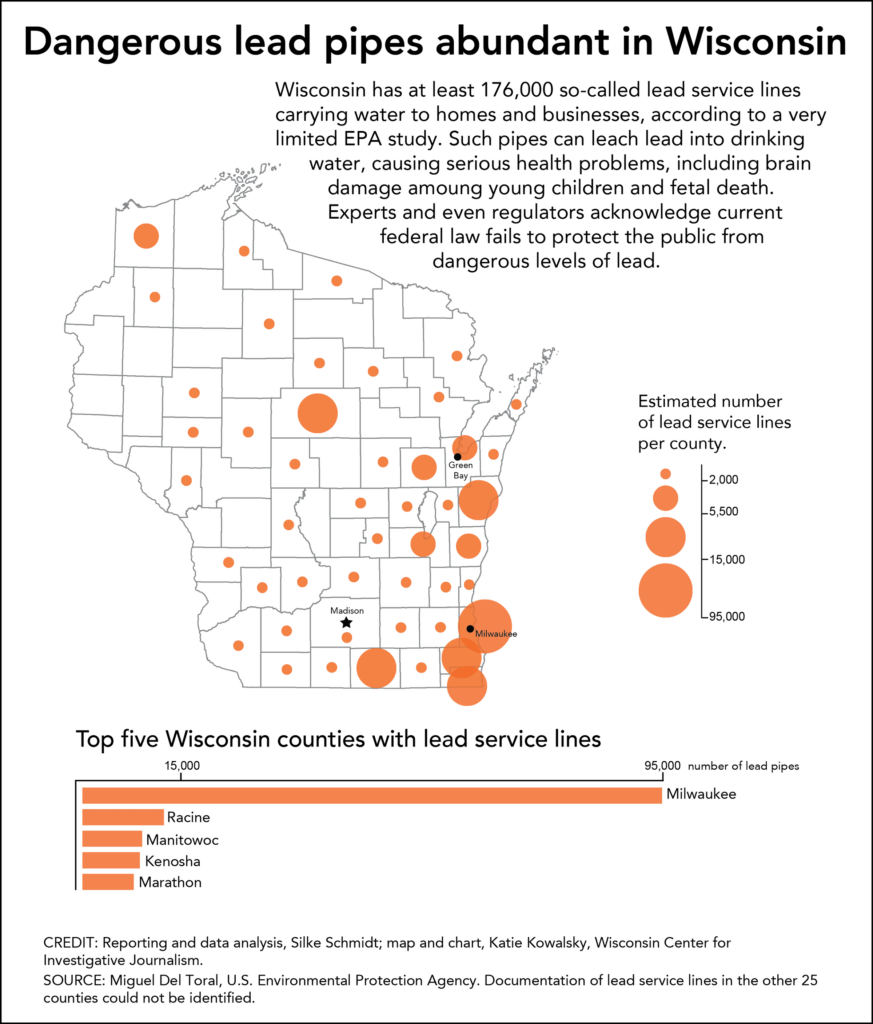While most people worry about lead in paint, lead in drinking water is still a serious threat in the Waukesha WI and Lake Country region.
Lead gets into drinking water through corrosion in plumbing systems and water service lines connecting homes to main water sources. In 1984 Wisconsin led the country when it banned using lead solder – a national law followed two years later. Unfortunately, some plumbing fixtures were still manufactured using lead until 1996. In 2014 a more comprehensive regulation became law nationwide – the Safe Drinking Water Act.
Lead isn’t usually found at drinking water’s source. It gets into the water from corrosion of pipes and fixtures. Homes built before 1986 are the most likely structures to have lead pipes, fixtures or lead solder connections. However, newer homes are not risk-free.

Lead In Drinking Water Service Lines
Even a house with no lead pipes or fixtures is at risk from lead contaminated drinking water if pipes connecting the home to main water lines are lead. The dangerous chemical enters drinking water when a chemical reaction takes place – simple corrosion. How much lead can enter the water depends upon several factors, including:
- The acidity or alkalinity of the water
- Additional minerals in the water – and related amounts
- Water temperature
- The age and wear in the pipes
- How long water stays in the pipes
- Protective coatings on the pipes
If you don’t think there are lead service lines underground in 2020, think again. In nearby Milwaukee the water department has a significant program to remove these potential threats to citizen health. They have already removed many lines in 2020 – and replaced nearly 1,000 in 2019. Milwaukee Country replaced more than 2,500 lines since replaced since 2017.
Professional Water Testing
The only way to find out if your home has high levels of lead is to have your water tested. Lead has no taste or smell in drinking water. And you cannot see it.
For your family’s safety and peace of mind, if you have any doubts call in a certified professional to assess your water system and sources. Schoenwalder Plumbing is Lead-Safe Certified by the Wisconsin Department of Health Services and licensed to deal with lead-related concerns. Its trained staff understands what it takes to deal with lead-related water issues.
If there is lead in your drinking water you have remedies available. Obviously, eliminating the source is a top priority. However, that isn’t always a viable option – replacing municipal lead water lines isn’t your call. After complete testing by a professional service, the best option is filtering your water. Water leaving its source seldom contains dangerous levels of lead. The water takes on the chemical as it travels through pipes and fixtures. You can reduce exposure to lead by installing a filter system.
The most basic filter system is a “point of use” design – anything from a filter cartridge in a pitcher to a system installed on or near your tap. You should filter all the water used for drinking and cooking. You cannot get lead poisoning from bathing in water high in lead content.

Filtering Out Lead In Drinking Water
There are several filters systems available certified by Federal standards for removing lead. When considering a filter unit look for an NSF certification – meaning the filters meet national standards for performance. There are different standards for varying levels of lead contamination. The simplest filters meet the requirements of NSF/ANSI Standard 53 and include:
- Pour-through pitcher/carafe styles where water drips through a filter.
- Faucet-mounted filters attached to kitchen faucets diverting running water through a filter.
- Countertop-connections to sink faucets through hoses or tubing.
- Plumbed-in units connected to a separate tap or kitchen sink – usually installed under the sink and filtering water through a dedicated faucet.
- Refrigerator filters dispensing water through a built-in system.
The NSF certification refers to both filter units and replacement filter cartridges. Lead should be among the elements listed on packaging as one the filter removes.
For more complete, whole house protection reverse osmosis drinking water treatment systems are the best option. A reverse osmosis system uses a membrane filter to reduce lead as well as dissolved solids and many other minerals. There are systems available for installation beneath your kitchen sink or to treat your whole house.
If you worry about the possibility of water contamination, contact Schoenwalder Plumbing – call, email or drop in – for advice and professional action. Our skilled, licensed plumbing professionals are lead-safe certified by the state and equipped to deal with your concerns. Well-versed in water treatment systems, we’ll repair or replace dangerous connections and install the appropriate system to eliminate lead in drinking water for your Waukesha WI and Lake Country home.
